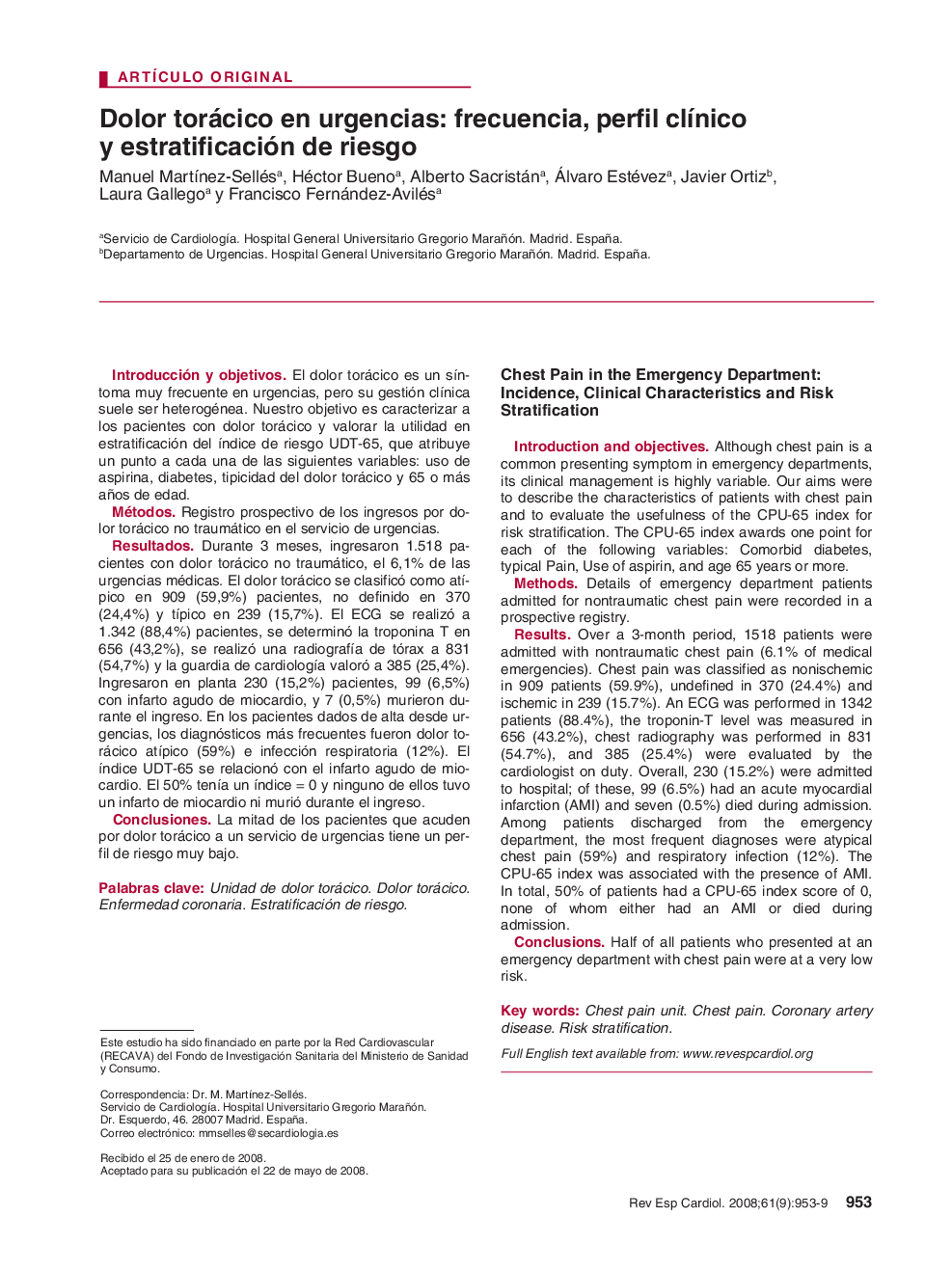| کد مقاله | کد نشریه | سال انتشار | مقاله انگلیسی | نسخه تمام متن |
|---|---|---|---|---|
| 3014729 | 1181907 | 2008 | 7 صفحه PDF | دانلود رایگان |

Introducción y objetivosEl dolor torácico es un síntoma muy frecuente en urgencias, pero su gestión clínica suele ser heterogénea. Nuestro objetivo es caracterizar a los pacientes con dolor torácico y valorar la utilidad en estratificación del índice de riesgo UDT-65, que atribuye un punto a cada una de las siguientes variables: uso de aspirina, diabetes, tipicidad del dolor torácico y 65 o más años de edad.MétodosRegistro prospectivo de los ingresos por dolor torácico no traumático en el servicio de urgencias.ResultadosDurante 3 meses, ingresaron 1.518 pacientes con dolor torácico no traumático, el 6,1% de las urgencias médicas. El dolor torácico se clasificó como atípico en 909 (59,9%) pacientes, no definido en 370 (24,4%) y típico en 239 (15,7%). El ECG se realizó a 1.342 (88,4%) pacientes, se determinó la troponina T en 656 (43,2%), se realizó una radiografía de tórax a 831 (54,7%) y la guardia de cardiología valoró a 385 (25,4%). Ingresaron en planta 230 (15,2%) pacientes, 99 (6,5%) con infarto agudo de miocardio, y 7 (0,5%) murieron durante el ingreso. En los pacientes dados de alta desde urgencias, los diagnósticos más frecuentes fueron dolor torácico atípico (59%) e infección respiratoria (12%). El índice UDT-65 se relacionó con el infarto agudo de miocardio. El 50% tenía un índice = 0 y ninguno de ellos tuvo un infarto de miocardio ni murió durante el ingreso.ConclusionesLa mitad de los pacientes que acuden por dolor torácico a un servicio de urgencias tiene un perfil de riesgo muy bajo.
Introduction and objectivesAlthough chest pain is a common presenting symptom in emergency departments, its clinical management is highly variable. Our aims were to describe the characteristics of patients with chest pain and to evaluate the usefulness of the CPU-65 index for risk stratification. The CPU-65 index awards one point for each of the following variables: Comorbid diabetes, typical Pain, Use of aspirin, and age 65 years or more.MethodsDetails of emergency department patients admitted for nontraumatic chest pain were recorded in a prospective registry.ResultsOver a 3-month period, 1518 patients were admitted with nontraumatic chest pain (6.1% of medical emergencies). Chest pain was classified as nonischemic in 909 patients (59.9%), undefined in 370 (24.4%) and ischemic in 239 (15.7%). An ECG was performed in 1342 patients (88.4%), the troponin-T level was measured in 656 (43.2%), chest radiography was performed in 831 (54.7%), and 385 (25.4%) were evaluated by the cardiologist on duty. Overall, 230 (15.2%) were admitted to hospital; of these, 99 (6.5%) had an acute myocardial infarction (AMI) and seven (0.5%) died during admission. Among patients discharged from the emergency department, the most frequent diagnoses were atypical chest pain (59%) and respiratory infection (12%). The CPU-65 index was associated with the presence of AMI. In total, 50% of patients had a CPU-65 index score of 0, none of whom either had an AMI or died during admission.ConclusionsHalf of all patients who presented at an emergency department with chest pain were at a very low risk.
Journal: Revista Española de Cardiología - Volume 61, Issue 9, September 2008, Pages 953–959